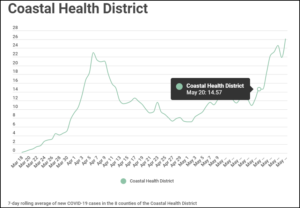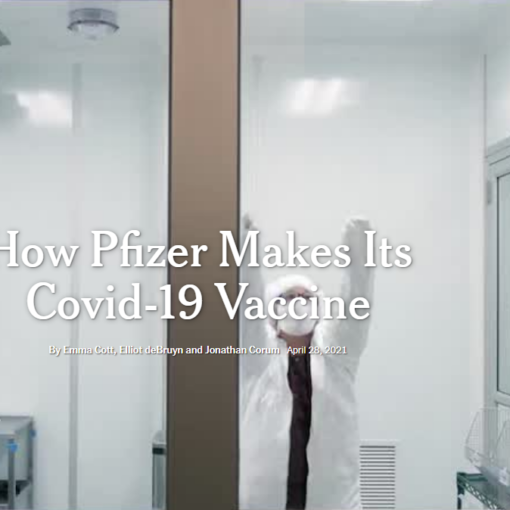
SUMMARY OF MAY 20th ZOOM MEETING WITH
DR. LAWTON DAVIS
DIRECTOR COASTAL HEALTH DISTRICT
GEORGIA DEPARTMENT OF PUBLIC HEALTH
[This is a summary of the meeting – for a complete transcript, click here.]
On May 20,2020, Dr. Lawton Davis gave a Zoom presentation to the Skidaway Hamiltons and Abigails regarding the COVID-19 pandemic, with a specific focus on Chatham County and Skidaway Island.
[Dr. Lawton used a chart that showed the 7 day rolling average of new COVID-19 cases in Chatham County – the chart included in this article has been updated on 5/27 – note that the rate of new cases has just about doubled in the past seven days]Dr. Davis began by providing a history of pandemics and our battle against germs more generally. Moving to COVID-19, he reminded us what was required for it to erupt to a pandemic: a susceptible population; a brand- new germ, that spreads very easily and can cause severe illness; Western cultural complacency; the ability to travel the world in a matter of hours.
He talked about Replication potential, or R value, of viruses…how many secondary cases will develop from each primary case. Early estimates of the R value of COVID -19 were in the 2.2-5.7 range, meaning the virus was highly contagious. He pointed out that R values change as more people are infected with the virus and develop immunity. That brings up the concept of “herd Immunity”, when there are relatively few people left to infect.
Dr. Davis talked about the local response to the emerging pandemic. Importantly, on March 11, the mayor of Savannah canceled the St Patrick’s Day celebration and the Music Festival shortly thereafter. Between March 13-20, Chatham County, the City of Savannah, and other regional municipalities declared a state of local emergency. In Chatham County, the Chatham Emergency Management Agency opened its operation center. The Coastal Health District provided staff and subject matter expertise. It has been a very effective partnership. Chatham County is vulnerable because it is a major transportation center. It is the 5th largest county in the state but ranks 20th in number of COVID-19 cases. The Coastal Health District is the 8th largest in the state (of 18), but it ranks second in the number of cases. All of this suggests a local flattening of the curve. The flip side of this that the number of people who have been infected locally is small and therefore we are far away from having herd immunity.
Dr. Davis then discussed the COVID-19 itself. It was originally felt to be primarily a respiratory illness, particularly dangerous for older individuals or those with underlying conditions. We now see that in some people the virus seems to preferentially infect the cells that line the blood vessels, leading to the development of blood clots. It may also be a factor in Pediatric Multisystem Inflammatory Syndrome, affecting children. Suffice to say, the spectrum of illness cause by COVID 19 is quite broad. Local epidemiologists report that the most common symptom reported is a bad headache for which there seems to be no reason. As has been widely reported, the fact that the virus can be spread from asymptomatic individuals constitutes a particular danger. Dr. Davis told of a nursing home study where everyone was tested after the first person had a confirmed diagnosis. 64% tested positive, but more than half of those were asymptomatic. Of those, 26% died. For this reason, a single case of CV19 in a nursing home is considered an outbreak, and all residents and staff should be tested.
Dr. Davis then talked about antibodies, immunities, and a vaccine. A particularly important question is whether infection and recovery confers immunity. There are no studies that support evidence of immunity to reinfection in humans. On the other hand, people do mount some type of immune response given the fact that the vast majority of those infected get well. Moreover, there is much encouraging research detailing the types of antibodies that should help protect us and those that should allow for the development of effective vaccine. Dr. Davis summarized some of the recent research. Dr. Davis cautioned that HIV has been present in the US since 1981. Humans develop all sorts of antibodies, but none of those antibodies are protective against reinfection, and there is no effective vaccine.
Regarding treatment, Dr. Davis indicated that there are multiple trials underway evaluating the efficacy of several different therapeutic interventions. He talked about Remdesivir and the over-hyped Hydroxychloriquine.
How will we ever emerge from this thing? We can either develop an effective treatment or develop herd immunity, or both. To achieve herd immunity, Dr. Davis said we must either become infected, recover, and develop protective antibodies, or develop an effective vaccine. Unfortunately, we have none of the above currently, and there is no assurance that we will in the future. What we can do is practice social distancing with other good public health hygiene practices, and we can do appropriate testing, with prompt reporting, aggressive case investigation, contact tracing, and appropriate quarantine or isolation.
Testing is slowly becoming more widely available. The RT-PCR test is the gold standard with a specificity and sensitivity of basically 100%. Unfortunately, in the real world, swabs taken from someone sitting in a car by a clinician are far less reliable. Because of human error, there is a false negative rate that may be as high as 30-40%. The antibody tests in good reference labs are highly reliable, but the rapid ones currently in local offices or urgent care centers are not to the same standard. The serum antibody test is not recommended as a diagnostic test as it may show a positive result because it is cross reacting with something else. All in all, utilizing an antibody test to determine that someone is OK to return to work does not make sense, at least for now. It is likely that reliable serum antibody tests will be much more widely available in the not too distant future. Assuming that research can determine that we do, in fact, develop decent short-term immunity, such tests could actually determine our level of herd immunity and whether it is safe to get back to some kind of normalcy.
Dr. Davis said, regarding reopening society at present, it would be wise to be cautious. He said it was important to understand that certain types of activities carry a higher theoretical risk than some others. It is well known that coughing or sneezing causes “’aerosol droplets” to expel at greater speed and volume. Singing, or anything that causes deeper breathing like exercise, also causes an increase in droplets. To become infected, one must inhale an amount of viral particles known as the inoculation dose. Such an infective dose is a function of the amount of droplets being inhaled and the duration for which they are inhaled. Brief interactions, from a safe distance, while outside represent a very low risk. Conversely, interactions in an enclosed space breathing “community air for any extended period of time, particularly if you or someone else is engaged in loud talking or singing, is a very high-risk situation. Think indoor restaurants, certain workplaces, and especially church services. Intergenerational gatherings are also highly problematic.





